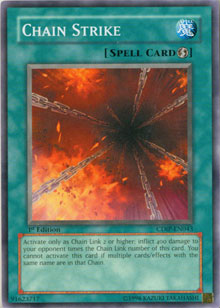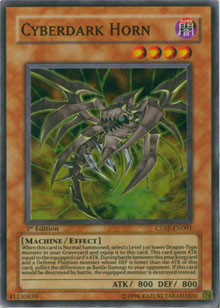Just hours remain before the final Shonen Jump Championship of the year, and one thing keeps running through my mind. Cyberdark Impact is finally legal for play in an SJC this weekend, and despite the lack of hype around the set, two new decks might make a big impact in tomorrow’s Day 1.
Chain Strike Burn
 A strategy that has sparked a great deal of controversy, debate, and drama over the past couple of weeks—the “almost-OTK” featuring Chain Strike, Accumulated Fortune, and a plethora of complementary chainables—has seen substantial success overseas in the hands of some of Europe’s best. It’s been quietly tested and played on the local level here in North America too, and the San Jose metagame may be ripe for the picking.
A strategy that has sparked a great deal of controversy, debate, and drama over the past couple of weeks—the “almost-OTK” featuring Chain Strike, Accumulated Fortune, and a plethora of complementary chainables—has seen substantial success overseas in the hands of some of Europe’s best. It’s been quietly tested and played on the local level here in North America too, and the San Jose metagame may be ripe for the picking.
The cool thing about Chain Strike burn is the number of current trends that it plays into, either taking advantage of popular deckbuilding decisions or effectively negating them altogether. The deck’s biggest strength rests in the fact that many builds don’t play a single monster. Triple Cyber Dragon cards? They’re 2100 ATK vanilla tributes if the opponent never lets you special summon them. Hydrogeddon? A 1600 ATK beatstick with nothing to destroy, and no way to search the deck for more of its ilk. Even Zaborg becomes a relatively terrible card—he has to kill off one of your own monsters when he hits the field.
The trend of rising monster removal is also countered effectively. If you’re packing plenty of Sakuretsu Armor, Bottomless Trap Hole, and Widespread Ruin cards in this matchup, you’ll quickly wish that you weren’t. They’re all dead cards, since it’s likely that the Chain Strike duelist will never summon. All in all, the average Lazaro/Spicer Monarch deck loses somewhere between thirteen and sixteen cards from its playable arsenal, and that’s just counting stuff like Mirror Force and Brain Control. I’m not even getting into less-than-desirable Zaborg the Thunder Monarch or Apprentice Magician cards that will never be destroyed in battle. Ouch.
In fact, the effects generated by Monarchs often become a very helpful chain link 1, making Accumulated Fortune easier to activate and Chain Strike even deadlier. Tribute Sangan for that Monarch and you give the Chain Strike burn player his or her first two chain links. Cyber-Stein users either get burned down below 5000 life points instantaneously, or Stein’s effect gets chained to for game. Even Dark World has problems, since the triggering of simultaneous effects through the discard of Goldd, Wu-Lord of Dark World, Sillva, Warlord of Dark World, and Broww, Huntsman of Dark World creates a big chain on its own.
Chain Strike burn is the culmination of a vast number of metagame trends over the past several months. Will anyone play it? I can’t help but think that if someone does, he or she has a great chance at making Top 8.
Zane’s Cyberdarks
 Cyberdark Horn, Cyberdark Edge, and Cyberdark Keel are pretty spiffy when you consider recent trends too. Each can attack over Cyber Dragon when armed with Masked Dragon or Twin-Headed Behemoth, neatly countering the triple Cyber that we’ve all come to know. Cyberdark Horn, undoubtedly the most popular Cyberdark right now, is brutal against the typical Monarch build. Treeborn Frog becomes a free 2000+ damage thanks to Horn’s piercing damage, and Apprentice engines don’t fare much better. In addition, though Mobius the Frost Monarch and Zaborg can take Cyberdarks apart, Thestalos the Firestorm Monarch has serious problems. An attack from the game’s hottest Monarch (no pun intended) leaves the assailed Cyberdark on the field thanks to its effect, so unless there’s a follow-up attacker, the Cyberdark player will be left with tribute bait for the next turn. The Cyberdark duelist can then roll that piece of field presence into a Monarch of his or her own.
Cyberdark Horn, Cyberdark Edge, and Cyberdark Keel are pretty spiffy when you consider recent trends too. Each can attack over Cyber Dragon when armed with Masked Dragon or Twin-Headed Behemoth, neatly countering the triple Cyber that we’ve all come to know. Cyberdark Horn, undoubtedly the most popular Cyberdark right now, is brutal against the typical Monarch build. Treeborn Frog becomes a free 2000+ damage thanks to Horn’s piercing damage, and Apprentice engines don’t fare much better. In addition, though Mobius the Frost Monarch and Zaborg can take Cyberdarks apart, Thestalos the Firestorm Monarch has serious problems. An attack from the game’s hottest Monarch (no pun intended) leaves the assailed Cyberdark on the field thanks to its effect, so unless there’s a follow-up attacker, the Cyberdark player will be left with tribute bait for the next turn. The Cyberdark duelist can then roll that piece of field presence into a Monarch of his or her own.
The Cyberdarks can dish out fast damage to render Cyber-Stein a dead card, pierce important Dark World monsters like Dekoichi the Battlechanted Locomotive and Morphing Jar, and even support the Monarch-stumping Deck Devastation Virus. The entire concept builds off of the pre-established Machine decks that have already been successful in this format, and there’s no question that companion cards like Cyber Dragon, Dekoichi, and Cyber Phoenix are worthy of top-level competition.
Will Cyberdarks hit the tables tomorrow? The deck seems less likely to see play than Chain Strike burn, but it could be a strong dark horse pick for a local group or independent player. Here’s hoping it sees some table time! It makes great use of some of the format’s top cards right now, including Thestalos the Firestorm Monarch, Pot of Avarice, and Enemy Controller, the latter of which brings us to this week’s Play to Make.
The Play to Make: Chaining Enemy Controller
I don’t know about your local metagame, but in mine, the release of the Champion Packs has caused the popularity of Enemy Controller to skyrocket. While it’s always been a well-respected card, the $30+ price tag has kept it out of the hands of many duelists for more than a year and a half. Its reprinting in Dark Revelations Volume 2 did little to make it more accessible, since many competitive duelists were content to horde the super rare version with just as much glee as the ultra. The DR2 set size was just too big for the reprint to have much of an impact.
Fast forward to today and, while the price of any holographic Enemy Controller is still way up there, the rare can be had for $10, or better yet, opened from a booster earned by registering in a tournament. That’s getting Controller into the hands of duelists who have never played it before, or who have at least never played it in multiples. The result is a whole new generation of players learning about the card’s versatility through trial and error. For those duelists, I present a short crash course and an important message: Enemy Controller is usually at its best when it’s chained.
Controller’s reprint comes at a time when it is perhaps more useful than ever before. Creature Swap is making a strong comeback, allowing duelists like Fili Luna to create sweeping offensive pushes out of thin air in conjunction with recruiters like Mystic Tomato and Giant Rat—Matt discussed this strategy just a week or two ago. If an opponent controls only a single monster, and it happens to be worthy of battle, then using Swap to trade a Tomato for it is nothing short of brutal. The opponent loses his or her monster, that monster attacks into the Tomato for some damage, and the Tomato then facilitates a direct hit with Don or Spirit Reaper. It’s a combo that creates a devastating impact on the duel, but Enemy Controller shuts it down. Once that recruiter hits the field and Creature Swap is activated, chain Enemy Controller to tribute your one monster. Take control of the Tomato and the opponent’s Swap resolves without an effect. He or she gets the monster back at the end of the turn and you’ve lost two cards, but you were already going to lose them anyway: your monster to Creature Swap and an in-hand card to Reaper or Don. This way, you don’t take damage, you get a chance to hit the recruiter with Smashing Ground or Zaborg on the following turn, and you can dodge a big play.
The situation becomes even more interesting when each duelist controls multiple monsters. It’s safe to assume that the opponent won’t activate Creature Swap without pre-existing knowledge that what they’re getting from you is useful. However, if the opponent controls one monster that’s great to Swap, and one that’s not so great (such as a set Dekoichi or Magician of Faith), then the same play can tribute a monster of your choice. Enemy Controller gives you control of the monster the opponent wanted to stick you with earlier than he or she planned. Then, when Swap resolves, it just pushes that monster back across the table, stealing the opponent’s more valuable one. In this case, the Controller player hasn’t just made an exchange of cards to stymie a bad situation. He or she has totally countered the opponent’s plan and turned it against the opponent as well.
It’s pretty great against reactive monster removal, too. Did the opponent flip Sakuretsu Armor to target your attacker? Does he or she have a face-up monster with worthwhile ATK? Chain Enemy Controller, tribute the doomed monster, take the opponent’s beatstick, and hammer home an attack. You lose two cards to your opponent’s one, but sometimes the resulting damage nets you the win anyway. It’s not just a great method of quickening the game’s tempo and forcing the opponent into action on the following turn, it’s also an opportunity to leverage extra cards into life point advantage, simplifying the duel and dealing damage in the process.
It stops Brain Control, too. Again, chaining in this situation tributes the targeted monster and loses you two cards to your opponent’s Brain, but if the opponent was relying on using your monster to bring out a Monarch, then you were going to lose two cards anyway. This way you deprive the opponent of a 2400 ATK beatstick and force him or her to either work with a smaller monster this turn, or pass. It’s a good move when you have specific cards on the field or in your hand that you need to protect, and denying your opponent a big attacker is always worthwhile. The 800 life points the opponent paid just adds insult to injury.
I personally expect to see a lot more Enemy Controller cards than usual tomorrow morning, so these plays (and similar ones) are going to be of the utmost importance this weekend. If you’re used to running Controller, get ready to see it a lot more often. If you just got your first pair of the powerful spell card, memorize these tricks quickly and learn them on an instinctive level. You’ll take your game to new heights.
See you tomorrow morning!
—Jason Grabher-Meyer